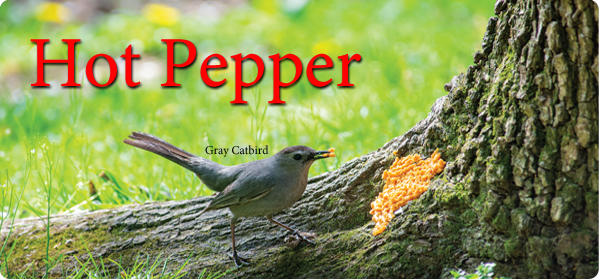
CEO and founder of Wild Birds Unlimited, Jim Carpenter, wrote a book called,"The Joy of Bird Feeding" This is information he provided on Hot Pepper Products in his book.
Does it work to discourage Squirrels?
“The use of Hot Pepper/Capsaicin products in birds food has been subject to some debate. Hot peppers contain a compound called capsaicin, which comes in all levels of “heat.” Capsaicin is added to wild bird foods as a powder or oil, mainly to deter squirrels, raccoons, and other mammals. It is clear that many birds will eat bird food with hot pepper products on them and that squirrels will avoid it.
One of the few tests of hot pepper bird seed was conducted in 2000 by scientists at Cornell.* They confirmed that capsaicin-coated seed works against Gray Squirrels, and that capsaicin-treated seed still appealed to wild birds. There were more bird visits to the feeders because the squirrels spent less time there. This study also showed that capsaicin-treated seed did not discourage Eastern Chipmunks, which filled their pouches and left to store the food. It was suggested that their fur-lined cheek pouches protected the chipmunks from the heat caused by the hot pepper seed.
Is it safe for the birds to eat hot pepper food?
In mammals, capsaicin from hot pepper interacts with a specific receptor protein called VR1 (vanilloid receptor 1) found on nerve endings, and evokes sensations of burning and pain. Scientist have isolated the VR1 receptor in birds and found that capsaicin does not bind to it, thus it does not produce a painful sensation. Capsaicin alone does not irritate or damage tissues in the mouth, eyes or digestive tract of birds. In fact, several species of birds and wild peppers have evolved a symbiotic (mutually beneficial) relationship, in which the birds consume the pepper’s fruits and then go on to disperse the seeds. Turkeys, Curve-billed Thrashers, Northern Cardinals, Northern Mockingbirds, Gila Woodpeckers, Cedar Waxwings, Elegant Trogons, Great Kiskadees, Tropical Kingbirds and Hepatic Tanagers have all been documented eating the fruits of different capsicum species in the wild.
Capsaicin-treated bird food has been on the market for over 15 years, and its anecdotal track record is remarkably unblemished. There are virtually no reports by ornithologists or hobbyists of the use of this food resulting in declines in feeder bird populations or causing the birds health problems. Although the anecdotal evidence to date strongly suggests that birds are unharmed by capsaicin-treated foods, there is still no empirical data providing that capsaicin is safe for all feeder birds.
Is it safe for hobbyists to offer hot pepper foods?
Capsaicin is added as ground powder or as liquid oil. Both coat the seed, and both coat the feeders that hold the seed. The powder has potentially greater danger than oil for humans at the time of filling the feeders as it is more easily separated from the seed by wind and may blow onto the hobbyist. The oil may have more danger to humans long-term as it will soak into wooden products and is not as easily hosed off of plastic and metal surfaces. The danger to hobbyists may not be at the time of filling the feeders (if they are wearing rubber gloves) but might come later as feeders with residual surface hot pepper are unsuspectingly handled without gloves. If eye, noses or lips are rubbed than a reaction to the hot pepper could range from mild to severe. Hot pepper can be added to suet products, bird food cakes, cylinders and seed. I have always felt that these are the safest use of hot pepper for humans as these “bind” the hot pepper. It cannot be blown into our eyes, and I feel that these products leave less residual oil or powder on our fingers and feeders than loose seed with hot pepper.”
From "The Joy of Bird feeding" by CEO and founder of Wild Birds Unlimited, Jim Carpenter.
*https://digitalcommons.unl.edu/cgi/viewcontent.cgi?article=1017&context=icwdm_wdmconfproc
"When considering feeding choices by frugivorous birds, it is important to recall that the evolutionary goal of fruiting plants is to make fruits attractive to seed-dispersing frugivores while deterring seed-destroying frugivores. Some plants appear to have accomplished this goal by producing compounds that are toxic to seed-destroying frugivores. For example, wild chili peppers use the compound capsaicin, which humans sense as the chili peppers' "heat," to influence which animals consume their fruits, and how long their gut retains the seeds. These pepper plants pack their fruits with capsaicin and relatively high concentrations of oils and proteins. Mammals, which tend to macerate and thus destroy the seeds with their molar teeth, can taste capsaicin, but birds lack the molecular receptor that capsaicin binds to and so do not sense this pungency. Video observations of plants in nature document that mammals avoid eating theses peppers, whereas some bird species (including thrushes, thrashers, and flycatchers) consume many. These same birds species are excellent seed dispersers for the plants, defecating the seeds unharmed after gut passage times of several hours."
-The Cornell Lab of Ornithology Handbook of Bird Biology Third Edition
Please give us a call or check MyWBU to inquire about current stock and prices. Thanks! (204)667-2161

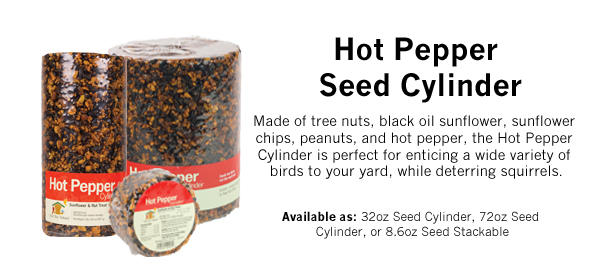
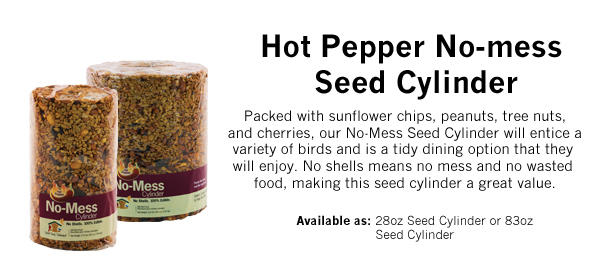
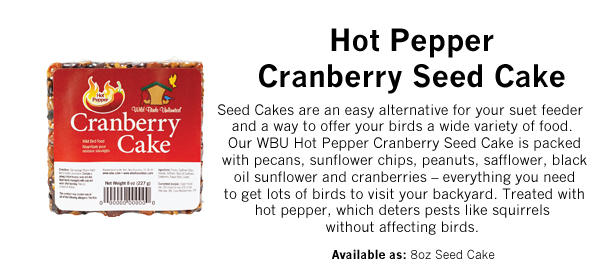

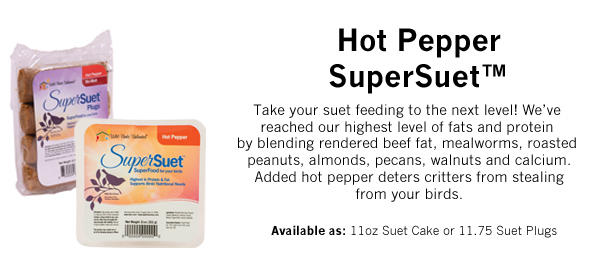

*Prices do not include taxes

